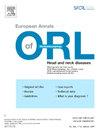Round window measurements for cochlear implantation with UHR-CT: Importance of the Stenvers plane and membrane size
IF 2.4
4区 医学
Q2 OTORHINOLARYNGOLOGY
European Annals of Otorhinolaryngology-Head and Neck Diseases
Pub Date : 2025-09-01
DOI:10.1016/j.anorl.2025.04.008
引用次数: 0
Abstract
Aim
To determine which anatomical parameters of the round window (RW) influence the surgical approach for cochlear implantation and in which plane they should be measured.
Material and methods
Sixty-six patients (40 females and 26 males; mean age: 60.4 ± 17.7 [26–84] years) who underwent preoperative ultra-high resolution CT underwent cochlear implantation between February 2020 and March 2024. Two radiologists reviewed the anatomical parameters of the RW niche (type, minimal width), membrane (size, inclination) and bony overhang (size, inclination) in the axial, parasagittal and Stenvers planes.
Results
The RW membrane size in the Stenvers plane was the most reproducible and the only difference between patients requiring a promontory cochleostomy approach and those with an easy RW approach, with an optimal cut-off value of 1.55 mm for the need for a cochleostomy. The RW membrane size in the parasagittal and Stenvers planes were highly correlated. The minimum width and type of the RW niche and the size and inclination of the RW bony overhang did not influence the surgical approach and had variable interobserver agreement.
Conclusion
The size of the RW membrane should be measured in the Stenvers plane. Other anatomical parameters of the RW do not influence the surgical approach.
UHR-CT对人工耳蜗植入的圆窗测量:斯坦弗斯平面和膜大小的重要性。
目的:探讨圆形窗解剖参数对人工耳蜗植入手术入路的影响及其测量平面。材料与方法:66例患者(女性40例,男性26例;平均年龄:60.4±17.7[26-84]岁,于2020年2月至2024年3月术前行超高分辨率CT行人工耳蜗植入术。两位放射科医生回顾了RW位(类型、最小宽度)、膜(大小、倾斜度)和骨悬垂(大小、倾斜度)在轴向面、副矢状面和Stenvers面的解剖学参数。结果:Stenvers平面内的RW膜尺寸可重复性最高,是简易RW入路患者与需行耳蜗造口术患者之间的唯一差异,最佳截断值为1.55mm。副矢状面和Stenvers平面的RW膜尺寸高度相关。RW骨位的最小宽度和类型以及RW骨悬垂的大小和倾斜度对手术入路没有影响,并且在观察者之间有不同的一致性。结论:应在Stenvers平面上测量RW膜的大小。RW的其他解剖参数不影响手术入路。
本文章由计算机程序翻译,如有差异,请以英文原文为准。
求助全文
约1分钟内获得全文
求助全文
来源期刊

European Annals of Otorhinolaryngology-Head and Neck Diseases
OTORHINOLARYNGOLOGY-
CiteScore
3.70
自引率
28.00%
发文量
97
审稿时长
12 days
期刊介绍:
European Annals of Oto-rhino-laryngology, Head and Neck diseases heir of one of the oldest otorhinolaryngology journals in Europe is the official organ of the French Society of Otorhinolaryngology (SFORL) and the the International Francophone Society of Otorhinolaryngology (SIFORL). Today six annual issues provide original peer reviewed clinical and research articles, epidemiological studies, new methodological clinical approaches and review articles giving most up-to-date insights in all areas of otology, laryngology rhinology, head and neck surgery. The European Annals also publish the SFORL guidelines and recommendations.The journal is a unique two-armed publication: the European Annals (ANORL) is an English language well referenced online journal (e-only) whereas the Annales Françaises d’ORL (AFORL), mail-order paper and online edition in French language are aimed at the French-speaking community. French language teams must submit their articles in French to the AFORL site.
Federating journal in its field, the European Annals has an Editorial board of experts with international reputation that allow to make an important contribution to communication on new research data and clinical practice by publishing high-quality articles.
 求助内容:
求助内容: 应助结果提醒方式:
应助结果提醒方式:


